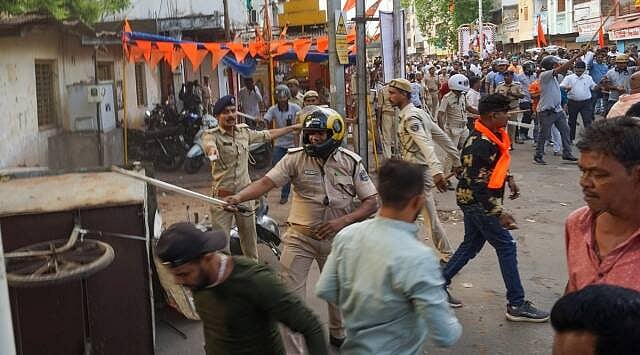Ram Navami: Nights and Days of the Long Knives
In a bigger, more barefaced declaration of intent, Ram Navami processions menaced their way yet again through Muslim localities during Ramzan

A cartoon circulating on WhatsApp groups and Twitter features a flustered Krishna pointing out ‘My temple is that way’, to which pat comes the reply from flag-waving devotees racing in the opposite direction, ‘May be. But we’ll get paid if we head to the mosque.’ Jokes in similar vein have been doing the rounds on social media.
Their punchline being that these days devout Hindus seem to be making a beeline to mosques to celebrate Hindu festivals. What’s not funny is the context of these shares—the violence that marred Ram Navami celebrations in several states this year, leaving 14 people dead and hundreds injured.
While the West Bengal police arrested a ‘BJP worker’ for flaunting a firearm in a Ram Navami procession in Howrah, an obscure outfit by the name ‘Hindu Front for Justice’ filed a petition in the Supreme Court in the ongoing hate-speech case, and claimed that Muslims were targeting the processions.
A section of the Muslim community, the petition claimed, ‘do not like’ Hindus celebrating their festivals, and urged the court to direct states to take action against ‘stone pelters’ and recover compensation from them for the damages.
While the Hindu Right expressed outrage at the perceived inability of Hindus to peacefully celebrate religious festivals, the BJP’s IT Cell chief Amit Malviya worked overtime to spread the narrative that Muslims were behind attacks on the processions.
Reports confirmed, however, that violence in most states occurred when Ram Navami processions passed through Muslim dominated areas. The processions invariably stopped in front of mosques and raised abusive and provocative slogans, in the presence of police.

Offensive songs targeting Muslims played on loudspeakers and young men with swords and tridents danced, jeered, made obscene gestures and hurled gulal at the mosques.
The processions timed their arrival at the mosques to coincide with evening prayers. With Ram Navami coinciding with the month of Ramzan, the provocations led to retaliation, which acted as a trigger for rioting, looting and arson. What is apparent is that the processions have become progressively ‘grander’.
Cavalcades of cars, trucks bearing a large number of people ferried from outside and fed well, ornately decorated raths, DJs and loudspeakers accompanying the crowd have become the norm.
A touch of menace has been added by arming the crowd of ‘devotees’ with polished and sharp sticks with flags tied at one end, which can conveniently be turned into weapons. Earlier, temples would collect donations to bring out the processions, but it is rare to hear of a donation drive these days—and yet a lot more money is clearly being spent on these processions. Who could be funding so many Ram Navami processions?
In Bihar’s Nalanda district, the ‘Hindutva’ mob set fire to Madrasa Azizia, the oldest madrasa in Bihar Sharif.
The 110-year-old library of the madrasa was vandalised and 4,500 books were destroyed in the fire. Petrol bombs were thrown inside the mosque. Also in Nalanda, CCTV cameras recorded images of the mob looting an electronics shop owned by Mumbai-based Javed Hamza. Electronic appliances worth crores were allegedly taken away. In UP’s Mathura, once the procession reached the Jama Masjid, the participants climbed on the roofs of neighbouring shops waving saffron flags. In Jahangirpuri in Delhi, a Ram Navami procession followed a route prohibited by the police.
In Vadodara, Gujarat, stones were pelted at Ram Navami processions passing through the communally sensitive areas of Fatehpura and Kumbharwada. Why permission was granted to go through the above-mentioned Muslim localities is a question that remains unanswered, even as police rounded up 34 alleged ‘stone pelters’.

Last year, violence had broken out during Ram Navami processions in Karauli in Rajasthan, Khargone in Madhya Pradesh, Anand and Himmat Nagar in Gujarat besides Hyderabad, Karnataka and Goa.
In Khargone, the police demolished the houses of the alleged stone pelters the very next day with the administration claiming they were illegally constructed—a pattern that is becoming routine in several BJP-ruled states. Bulldozers were in fact part of the Ram Navami procession in Howrah, West Bengal.
While the Hindu right would have people believe that communal polarisation benefits secular parties and triggers ‘Muslim appeasement’, research findings by Yale University concluded that Hindu nationalist parties gained as much as 0.8 per cent votes following communal violence in the year preceding the election. In West Bengal, political pundits believe that both BJP and Mamata Banerjee stand to gain from polarisation.
West Bengal CM Mamata Banerjee has called upon Hindus to ‘protect’ Muslims and wondered why Ram Navami processions were still on five days after Ram Navami. Her Leftwing critics wonder why her police allowed so many Ram Navami processions, unknown in the state till recently. (Bengal’s main Hindu celebration being Durga Puja, which is a peaceful and festive affair in contrast.) If there is something even more alarming than the open baiting of minorities these incidents represent, it is the apparent complicity of the administration and the police.
Follow us on: Facebook, Twitter, Google News, Instagram
Join our official telegram channel (@nationalherald) and stay updated with the latest headlines